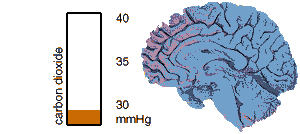How Breathing is Controlled
The respiratory centre in the brainstem is responsible for controlling your breathing rate – it sends a message to your respiratory muscles telling them when to breathe. This control is automatic and continuous. You do not have to consciously think about it. However, this control can be influenced by emotions, talking and calculated thoughts such as when you dive into a swimming pool.
But how does the respiratory centre know when to breathe?
It “knows” how to control the breathing rate by the amount of carbon dioxide in the arterial blood. For example, when you exercise, carbon dioxide levels increase which excite the respiratory centre. It strengthens the signal – stimulating the breathing. Responding to this stronger signal, the respiratory muscles increase both the speed and depth of breathing.
This increased respiration rids the body of excess carbon dioxide and supplies the body with more oxygen, which is needed when you exercise. When the level of carbon dioxide in the arterial blood returns to normal levels and the respiratory centre is no longer stimulated and breathing becomes quiet and relaxed.

Carbon dioxide acts as a marker. When carbon dioxide levels reach a certain point, the respiratory centre in our brain sends a message to the muscles used for breathing to take in more air.
